by Robert Cowlin
The Sound & Vision show takes place annually in Bristol and is the UK’s largest and longest running gathering of Hi-Fi manufacturers and enthusiasts. I had hoped to go last year but band commitments got in the way so my wife organised for us to go this year for my birthday. It was our first time visiting a Hi-Fi show and presented an exciting opportunity to hear many brands that we had read about but never had the chance to audition, we were also able to experience some indulgent cost-no-object configurations. The show was hosted at Bristol’s Marriott Hotel, with the ground floor conference suites being dedicated to larger demonstrations for twenty to thirty people per slot, and the hotel’s guestrooms being taken over by the smaller brands that convert the rooms into mock listening areas and living spaces in order to demonstrate their products to about six persons at a time. We went for two days, which was enough time to comfortably visit all the large demonstration rooms as well as all four additional floors worth of smaller demos. We could probably have done the whole thing in one day but it was nice not having to rush and being able to revisit some of our favourite rooms. The building was consistently packed for the entire time that we were there.
I wrote down our thoughts on some of the demonstrations and will outline them below, but first a couple of general observations. I was impressed by the number of manufacturers that had made a concerted effort to bring acoustic treatments to their demonstration rooms. Hotel rooms are hardly great for listening to music in, especially when every other room on the floor is pumping out tunes as well. A lot of manufacturers had brought bass traps and acoustic panels with them to treat the rooms, and the home cinema manufacturers were using digital room correction in their demos to improve the acoustics. I would estimate that around half of the manufacturers at the show were using some form of physical or digital acoustic treatments to improve the sound and those rooms unquestionably sounded the best. It is important to keep this in mind when reading my sonic observations below as not all the rooms were treated, but there really is no excuse when so many brands had brought something with them. Unfortunately, a lot of the manufacturers relied on either extremely bright or dynamically compressed digital music to demonstrate their products. In my opinion, this proved detrimental as it was countered by other manufacturers using excellent sounding vinyl set-ups to show off their products. I am very much a digital music enthusiast over vinyl, but the limitations of the vinyl format proved advantageous when compared to manufacturers that were playing hyped-up bright sounding productions in an attempt to entice attendees into their rooms. Generally, the rooms playing records sounded better because the lack of brightness or over compression allowed us to get a better impression of the products that were being exhibited without getting ear fatigue. Finally, the constant harping on by the brand representatives about ‘CD quality’ and ‘high-resolution’ got very tiring. We were regularly reminded that the demonstration tracks were only CD quality, and just think how much better this would sound with high-resolution audio being played. I am pretty sceptical about high-resolution for playback purposes and have never seen any evidence that a high-resolution master and its CD counterpart can be reliably identified in a blind test. Most of the attendees appeared to lap up the high-res voodoo talk however.
I have created a Spotify playlist of track highlights from the demonstrations reviewed below. Listen along and see if you can hear what I am talking about.
Brand Reviews:
ARCAM
Situated in one of the larger conference suites, ARCAM was demonstrating its AV860 Dolby Atmos & DTS:X 7.1.4 AV processor, with KEF providing the surround speakers and four Atmos ceiling speakers plus two bespoke sub-woofers with Celestion drivers. The amps were set up in a bridged mono-block configuration, with one amp per speaker providing 1,000 watts per channel of power. The overall cost of all the amps, speakers, 4K projector, and screen was around £100,000. The brand rep jokingly described the set up as their “lifestyle range”. The rep informed us that the demo was using Dirac digital room correction and played some rain sound effects with Dirac on and off to great effect. He then played the opening scene from Mad Max: Fury Road. The sound was immense and the picture quality was perfect, the demonstration immediately put every cinema I had ever attended to shame. The demonstration finished with a clip from a Paul Simon concert filmed in HD. I almost clapped at the end of the song, it was that convincing!
ASTIN TREW
I had not heard of this brand before but AT was launching its AT2-210 integrated amplifier, using a Planalogue ‘Prelude’ turntable with ‘Sibelius SG’ floor-standing speakers by Pearl Acoustics. We were the only people in the room so I chose “Vicious” by Lou Reed as the demo track. There is a repeating cowbell on this track and on this set up it was all we could hear. Reed’s vocal was lost somewhere down the hall but that damned cowbell just kept clobbering us over the head every second. Very tiring indeed. The ‘Prelude’ turntable looked an impressive piece of kit however.
AUDIOENGINE
The room was set up like an office as Audioengine was demonstrating its tiny HD3 Wireless active speakers, placed either side of a computer monitor. I connected to them via bluetooth and streamed Bullion’s “It’s No Spirit” from Spotify. I was not particularly impressed. The speakers failed to control the song’s pulsating and potentially flabby sub-bass, instead just spluttering out a choked boom throughout the track. The brand rep started talking over the sonic mess, probably for the best.
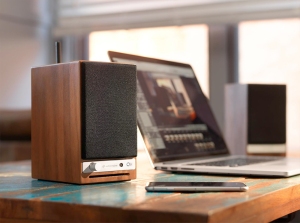
HD3 Wireless speakers
AUDIO NOTE UK
I have read a lot about this brand, it appears to have a bit of a cult following particularly on US Hi-Fi forums. Audio Note had a CD transport and DAC combo feeding one of its amplifiers (didn’t get the names) with the ‘AN-J’ speaker at the end of the chain. Fleetwood Mac’s “Oh Daddy” started playing as we entered the room. This is a track we are quite familiar with so it was a good opportunity to make some brief evaluations. The sound was very polite and pleasant, quite a lot of mid-range detail. I did however notice that the track’s snare drum seemed to have a bit more added punch than normal, so perhaps the speakers have some reinforcement somewhere in the mid-range. This characteristic carried over to the next song, a female vocal track. Each time the singer held a particular note the sound became unpleasant.

AN-J speaker
BOWERS & WILKINS
Another mega-bucks surround sound demonstration, this time by B&W. We heard the flagship ‘800 D3’ in a 5.2 configuration with the new ‘DB1D’ sub-woofer. First, the rep passed around some of the driver elements that go into building the 800 Series speakers. The metal structures were incredibly hefty and made no echo if you tapped on them. Impressive engineering on display. The rep then played Lou Reed’s “Vanishing Act” in stereo to great effect. The speakers had a vice-like grip over every speck of sound, the scale was of course massive. The rep demonstrated how well isolated the sub-woofer is by placing a glass of water on top of it and playing a bass heavy drum track. He called it the Jurassic Park test, the water remained still throughout the whole track! The demonstration concluded with the opening scene from Unbroken. The whole experience was incredibly tense and dramatic, with the various surround effects rendered to perfection. I wonder if you might feel a bit locked in by it all in the long-term, the sound was that commanding. The cost of the system was £60,000.
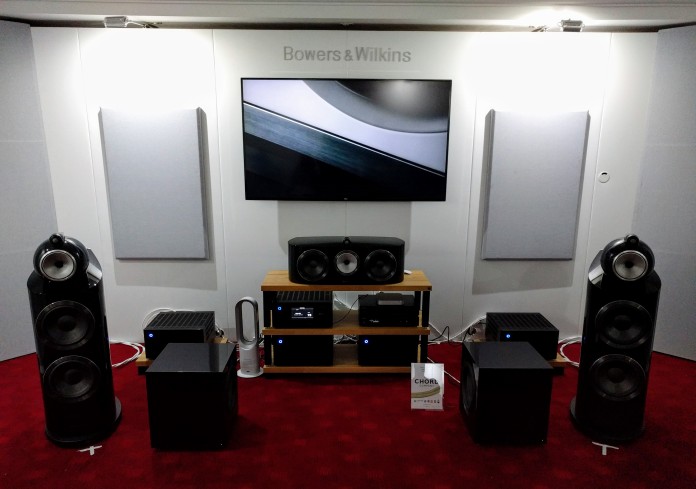
CYRUS
This room was pretty cool. Cyrus was demonstrating its new ‘ONE’ integrated amplifier, a reboot of the original Cyrus One from the 1980s. Cyrus had a selection of its milestone products on display from the last thirty years and was demonstrating the new ‘ONE’ amplifier with three different speakers and Audioquest Nighthawk headphones (the new amp includes a very capable headphone amplifier). I was not familiar with the speakers or the song selection, and the brand rep kept taking forever to introduce the tracks and then only played them for thirty seconds! Nevertheless, one quality that I noticed across all the tracks and speakers was that the sound was incredibly clear and lucid without a hint of brightness or fatigue. I really enjoyed listening to the amplifier and found the half-width case aesthetically appealing.
DEVIALET
The self-proclaimed “best sound in the World”, Devialet makes a curious range of curved wireless speakers with mouthwatering specs. At the Bristol Show, Devialet was demonstrating its new ‘Gold Phantom’ loudspeaker. It (perhaps unfairly) struck me as a sort of Hi-Fi lifestyle product, retailing at ~£2,000. The sound was very good and benefited from the speakers being set up in a tight rule of thirds configuration with only two chairs for listening. Stevie Wonder’s “Superstition” was playing and the Gold Phantoms conveyed the song’s rhythmic elements and crunch with ease with excellent stereo separation to boot. Looks wise, the Phantoms are very much a marmite product that no doubt will compete with KEF’s new LS50 Wireless speakers (discussed below).
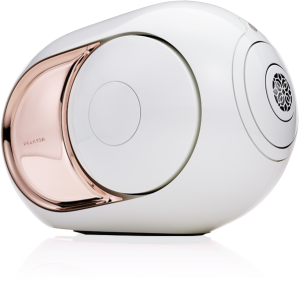
Gold Phantom speaker
DYNAUDIO
Celebrating its 40th anniversary and exhibiting the What Hi-Fi 2016 Product of the Year ‘Emit M20’ stand-mount speaker (among other models), the sound in the Dynaudio room was very impressive. The M20’s imaged with pinpoint precision, emphasising the importance of space between one’s speakers, and had a pleasant airy quality that would certainly suit warmer sounding electronics. They retail at £600, I expected them to be twice that price.
Demo track: Stevie Ray Vaughan – “Tin Pan Alley”.
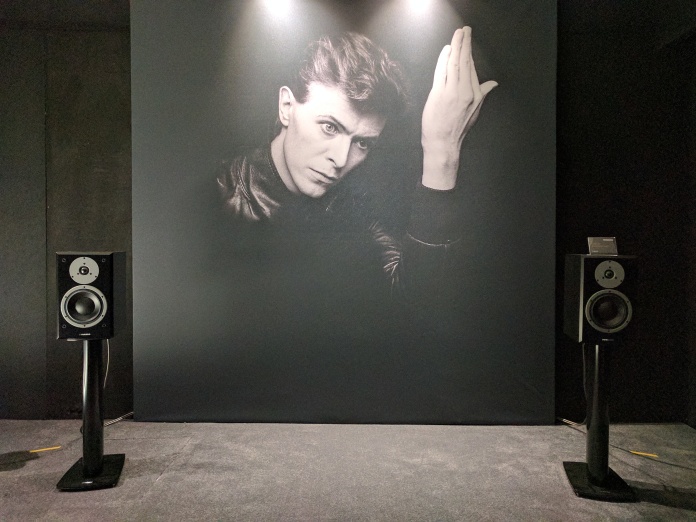
Emit M20 speakers
HARBETH AUDIO
Quite possibly my favourite room of the show that has left me coveting a pair of Harbeth loudspeakers! Harbeth was also celebrating its 40th anniversary and demonstrating the limited edition ‘SHL5plus’ large stand-mount speaker. Unlike many other rooms, designer Alan Shaw was playing a selection of classical and jazz recordings with the idea being to convey a subtle and nuanced sound rather than the whizz-bangs going off elsewhere. The speakers framed everything perfectly and had an addictive and comforting sound that you could listen to for hours. Highlighting the fact that speakers are probably the most important part of a Hi-Fi set-up, Alan was simply playing tracks from his portable digital player to superb effect. No high-res gimmicks, no exotic cabling, very little in the way of isolation. Just great speakers. Quality clean amplification was provided by Norwegian manufacturer, Hegel. If you ever get a chance to hear a pair of these speakers do not hesitate! Dynamic range, realism, and perfect sound await!
Demo track: Art Blakey – Moanin’.
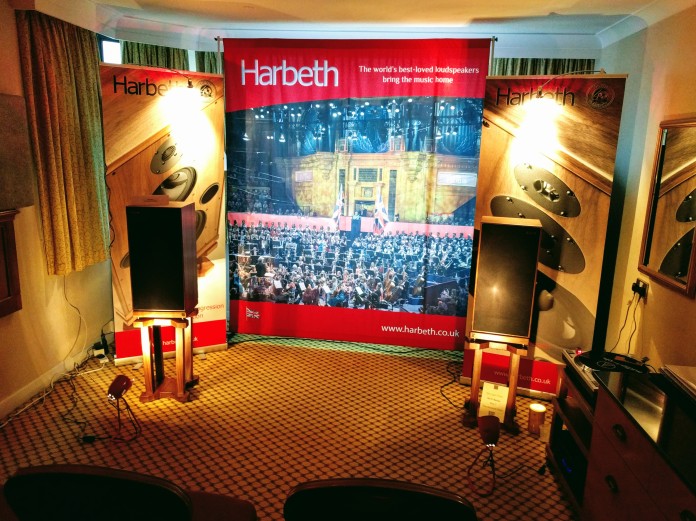
SHL5plus speakers
ICON AUDIO UK
A room full of modern valve amplifiers, valve phono stages, valve CD players(!), and valve headphone amplifiers from award winning valve Hi-Fi manufacturer Icon Audio. Far too many things to list but Icon was demonstrating its massive 15″ horn speakers which did not sound as impressive as they looked.
Icon Audio display
KEF
I own a pair of KEF’s award winning LS50 speakers so I had to hear what it had come up with for the new LS50 Wireless active version on demonstration at Bristol. One issue that people have reported with the passive LS50 is that it is a bit fussy about what amplifier it is paired with. I have not experienced any issues with it connected to my Rega Elex-R, but I think – given the speaker’s relatively affordable £800 price tag – many owners try to mate it with entry-level amplifiers that do not have enough power to properly drive the KEFs. It appears that one really needs an amp in the same price range as the LS50 (or higher) to get the best out of the speaker. With this in mind, KEF has decided to create an active version of the LS50 with purpose built dual amplifiers inside (one for the mid/bass driver, one for the tweeter), thus solving the potential amplifier pairing problem. The new LS50 Wireless is a complete Hi-Fi solution, with everything happening inside the speaker boxes. You just add stands and cables, then control everything via your phone or tablet. Design wise, it is the same as the original LS50 but with the amplifier and DAC added to the back, so they are pretty deep! Three tracks were used to demonstrate the speaker’s most noteworthy qualities: scale, sound-stage width, and pinpoint imaging. We were sat at the back and still the spatial cues were faultless despite us not actually being able to see the speakers. The speakers come with a phone app that lets you dial in DSP room correction, compensating for room dimensions and speaker placement. If I did not already own a pair of passive LS50s the new active version would definitely be on my audition list.
Demo track: Malia – Celestial Echo.
MISSION
The only real attempt at budget Hi-Fi in the whole building, Mission was showing off its What Hi-Fi award winning LX-2 stand-mount speaker (£160). We were the only ones in the room at the time so we picked “Kooks” from the 2015 remaster of Hunky Dory. The LX-2s did an admirable job of rendering Bowie’s vocal, but not much else. The song’s tuneful yet subtle bass was non-existent and there was very little realism on the piano. Overall, a somewhat unbalanced presentation. Bizarrely, the speakers were being fed by hundreds of pounds worth of quality Audiolab electronics so the source certainly was not at fault. The speakers were quite far out in the room given their size, and perhaps would have performed better in a smaller environment where reinforcement from the main wall would have improved the bass. Nonetheless, I have heard better budget speaker performance from the likes of Wharfedale and Cambridge Audio in the past.
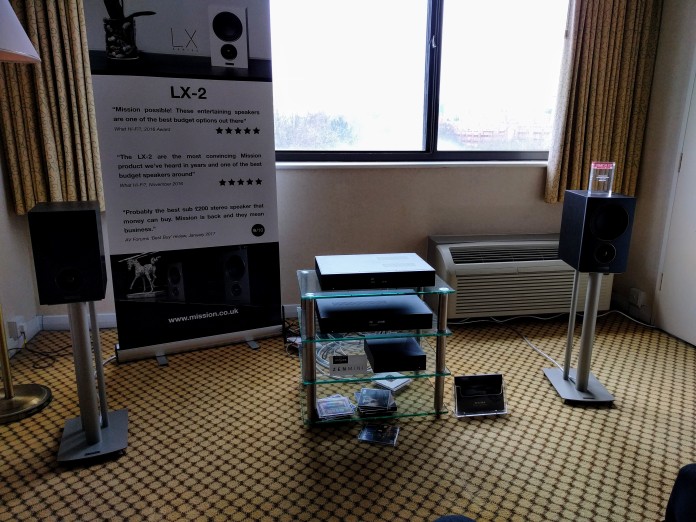
LX-2 speakers
MQA
MQA is a new file format, developed by Meridian, that aims to bring high-resolution audio streaming into the home. It is able to compress 24-bit high-resolution audio master files into sizes that are similar to 16-bit FLAC/ALAC files. It can do this because MQA uses lossy data compression to achieve its small file size, whereas FLAC and ALAC utilises lossless compression. Consequently, a high-resolution audio master file converted to FLAC/ALAC will retain all of its audio information, whereas the same master file converted to MQA will be much smaller in size but lose some of its audio information forever. MQA is currently being used by Tidal to stream high-res audio to subscribers. MQA was being demonstrated by Bluesound, who makes a selection of sleek network streamers and amps, and Audioquest, who brought its newly MQA-enabled Dragonfly USB soundcard to the show. The companies were demonstrating with MQA off and then on. Can YOU hear the difference? etc. Bluesound was using a more realistic pair of B&W floor-standing speakers than what we had heard in the B&W room earlier, the sonic characteristics of the earlier B&W demo remained the same though, which was interesting to note. Audioquest had its Dragonfly soundcard connected to a splendid Rega Elicit-R amplifier and speakers that I do not recall the name of. Both demos used a pre-digital era jazz vocal recording and Adele’s “Hello” to demonstrate the apparent difference between CD quality and the supposedly superior MQA. We were the only people in the Audioquest room so took the opportunity to test the rep on his knowledge. The jazz vocal track had an excruciatingly high analogue tape noise floor and I mentioned that any benefit between 16-bit CD quality and 24-bit high-res MQA would be redundant on this track because its high noise floor was obscuring any audible differences happening below -96 dBFS. I told the rep I could not hear any difference and he went: “Right! Let’s try Adele!” The track, “Hello”, is mastered so loud that it has just 4 dB of usable dynamic range. We blissfully sat there, switching back and forth between a CD file capable of containing 96 dB of dynamic range, and the high-res counterpart capable of 144 dB of dynamic range. Both of these ‘buckets’ are capable of rendering “Hello” in all its DR4 glory without hindrance or any audible difference. I tried to explain this but Audioquest was having none of it! By now a few more people had come in and I was loudly proclaimed to be the only person throughout the entire weekend that could not hear a difference between CD and MQA, much to my delight and pleasure! Shortly afterwards I returned to the Harbeth room to hear properly mastered songs being played off a smartphone with incredible sound, go figure.
MUSICAL FIDELITY
I previously owned Musical Fidelity’s excellent entry-level V90 DAC and often regret selling it. However, I have had the opportunity to hear MF amplifiers at dealers and now at the Bristol Show and have always come away with the impression that they exhibit a false sense of air or top-end extension. MF was showcasing its ‘Encore Connect’ all in one music player (files, streaming, CD, etc) and ‘NuVista 600’ integrated amplifier. Speakers were KEF ‘Reference I’ stand-mounts. Lots of brands were using various KEF speakers throughout the show, and this was the only time when we both felt they sounded brash and false in the top-end. I can only assume this impression was down to the Musical Fidelity electronics. In addition to the unpleasant sound, the huge components were finished in a hideous mid-nineties computer off-white colour, the kind you might associate with an old CRT monitor or keyboard. Next!

Musical Fidelity display
NAIM AUDIO
Naim had taken over the executive lounge to demonstrate its new ‘Uniti’ range of products. It is another all in one solution that includes streaming, bluetooth, radio, network sharing, and apps that basically means you never need to move ever again. To my delight, the new range also promotes file-based playback specifically from CD rips and Naim has built a device that rips, stores, backs up, and serves your music to the network (‘Uniti Core’, £1,800). With more audiophiles collecting older CDs to get a specific mastering or out of print recording, or simply buying CDs because they are currently so cheap, it is now more important than ever to back up one’s CD collection to a lossless archive. Older discs can contain errors that ordinary disc-based playback would struggle with, but if you rip the disc you are more likely to get files that play perfectly because, when ripping a disc, error correction is not time-domain limited, i.e. the software can spend as long as it likes ripping a problematic track whereas a CD player only has a couple of seconds before having to come up with a fix or it skips. Using software such as dBpoweramp with AccurateRip enabled, one can ensure that a ripped CD is in fact a perfect copy of the disc by automatically comparing the CRC codes from the rip with a user-generated database of codes. If the rip’s CRC codes match someone else then it is an accurate rip as the likelihood of errors being identical across rips is almost impossible. Frustratingly, when the Naim rep promoted lossless CD ripping, he simplified it dramatically by saying: “CD players lie to us because they use error correction, whereas ripped files do not need error correction”. Well, that is sort of true, but the act of ripping a CD might still require the use of error correction in order to accurately rip the disc. I assume/hope Naim’s ripping system includes error correction! The rep did not say whether the ‘Core’ uses AccurateRip or indeed whether it has any method of informing the user that it has achieved a secure/insecure rip. I would not like to be on the receiving end of an irate Naim customer whose wonderful collection of ripped discs all contain audible errors and skips! The Naim rep played five tracks (jazz, classical, rock, female vocal, electronic) through the ‘Uniti’ kit and Focal ‘Sopra No. 3’ floor-standing speakers (£15,000). I have long wanted to hear the ‘Naim sound’ so I was looking forward to this demo but I was quite unimpressed. There was lots of attack, you knew precisely when a note was struck, but the amount of detail was so dizzying that I wondered how much processing was going on inside those boxes. The whole sonic picture was ruthlessly forward and off-putting. How could one listen to that for extended periods? As we went round the show we noticed a few other manufacturers using Naim components in their demonstrations, including some headphones, and that sonic characteristic remained apparent.
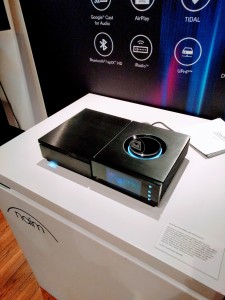
Uniti Nova
PRIMARE/REVEL
Swedish electronics manufacturer, Primare, teamed up with US speaker manufacturer, Revel, to present one of the best sounding rooms of the weekend. The minimalist set-up consisted of Primare’s EISA award winning ‘I32’ integrated amplifier (£2,000) and ‘NP30’ network player (£2,000), feeding Revel’s Concerta2 M16 stand-mount speakers (£950). The sound produced by this set up was clean and open. As with Harbeth earlier, the rep took a more relaxed approach to song selection and mixed older more dynamic recordings in with modern productions. I do not have much more to say other than it sounded excellent with no single element causing any offence or annoyance.
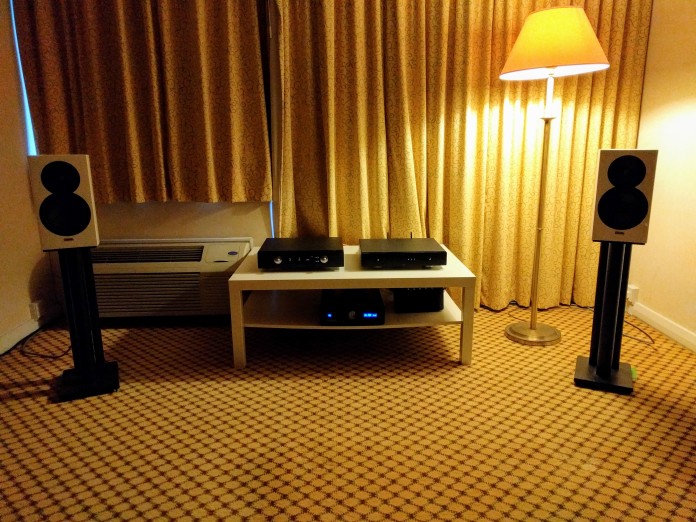
REGA RESEARCH
Rega was showcasing its new ‘Planar 3’ turntable and the 2017 iteration of its award winning ‘Brio’ amplifier. It also launched an MC phono stage, modified TT PSU with variable speed control, and digital stylus gauge for accurately setting VTF to two decimal points at the show. The system was playing through Rega’s ‘RX-5’ floor-standing loudspeakers. The new turntable is extremely light and good at dispelling airborne vibrations. I previously demoed Rega’s RX-1 stand-mounts to go with my Rega Elex-R and DAC-R but thought they sounded too dull. At Bristol, the RX-5 certainly sounded better than I remember the RX-1 sounding, not dull at all, but perhaps a bit too open on the top end.
SENNHEISER
We found out that Sennheiser would be exhibiting its £50,000 ‘HE 1’ headphone and amplifier combo at the Bristol show so booked a slot in advance to hear it. We fed the amp with lossless CD rips from my iPod via a FiiO line-out dock to essentially mimic the output of a CD player. The sound was just incredible. As expected, it was the best sounding headphone rig I had ever experienced, digging up newfound detail in performances and unveiling instrumental characteristics that I had not heard before, as well as lifelike vocal realism and exquisite separation. Motorhead’s “Ace of Spades” sounded incredible through it, with the drumming in particular gaining an additional sense of realism, particularly during the mid-track rim-shots.
TECHNICS
I was itching to see and hear the just announced ‘SL-1200GR’ turntable, which made its UK debut at Bristol alongside last year’s ‘SL-1200G’ reference turntable. The new GR iteration is almost identical to the classic SL-1200 MK2 and will retail at £1,299, whereas the reference G version is ~6 kg heavier, has a magnesium finished tonearm and brass platter, and retails at £2,999. The cartridge was Ortofon’s 2M Black PnP (~£500) and this was all feeding Technics’ ‘SU-C700’ amplifier (£1,250) and ‘SB-G90’ floor-standing speakers (RRP TBA). With the exception of the added weight, both turntables felt identical to use. Everything was supremely machined to perfection and felt even more sturdy than my trusty SL-1210 MK2 at home. On the whole, the sound of the full Technics system was a bit restrained, with vocals being slightly recessed, however resolution of very low level detail on David Bowie’s “Lazarus” was excellent and I definitely noticed quiet effects that I had not heard before. Perhaps the set up just needed something to wake the mid-range up a bit, maybe a change of cartridge?
That’s it for the 2017 round-up. Roll on 2018!












